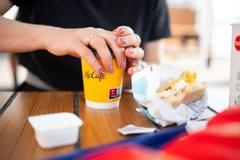Crustacean packaging: Australian start-up creates “waste-negative” single-use alternative to plastics

26 Jul 2019 --- An Australian start-up has developed a biodegradable alternative to plastic food packaging produced from the chitin and cellulose contained in crustacean skeletons. The material – CARAPAC – has embedded anti-fungal properties that prevent mold or fungi from growing on fresh produce and it can extend the shelf-life of fresh fruit and vegetables by up to seven days. CARAPAC also improves the quality of soil by adding nutrients when it biodegrades, making it ideal for gardens and plants pots, as well as home composts. Although still in the product development phase, the team are commencing customer trials and partnering with a manufacturer for a potentially large-scale operation.
The material comes in semi-rigid, soft and cling-film forms, enabling the CARAPAC Company to make a whole range of different types of packaging including bags, sleeves, cling film, trays and punnets in most shapes and sizes.
“CARAPAC is suitable for packaging fresh produce, confectionery, baked goods, other consumer goods and potentially meat packaging,” Kimberly Bolton, CEO of Carapac and Co-Founder along with Jared Wood and Michelle Demers, tells PackagingInsights. “We can also make bags for other purposes, like fashion.”
“Fresh produce is just our first target, however, the long term goal is to move into packaging for a broad spectrum of purposes and industries. For example, our clingfilm could be used to replace pallet wrap which is a large contributor to plastic waste.”
“We do recommend that it is used for packaging that needs to last a maximum of two years. It is also moisture-resistant, but not moisture-proof, so it cannot be a water bottle or replace cans or jars,” Bolton adds. CARAPAC can extend the shelf-life of fresh produce by up to seven days compared to plastic alternatives.
CARAPAC can extend the shelf-life of fresh produce by up to seven days compared to plastic alternatives.
The environment is losing its battle against single-use plastics, a fact made more frightening when one considers that 300 million tons of plastic are produced each year. Biodegradable products seem like the obvious alternative, but many of these products are less environmentally-friendly than they seem, Bolton says.
Other biodegradable plastic materials such as PLA and PHA are recyclable and industrially compostable, but many recycling plants do not support these plastics and compost facilities remove them because they think they are normal plastic. These “biodegradable” plastic materials still take up to five years to breakdown and can produce methane, a harmful greenhouse gas.
CARAPAC believes it has found a better way. In their quest to eliminate waste, the team researched various plastic alternatives, but finally looked to the frozen food processing industry. Food processing plants in Asia and Australia cumulatively produce 8.1 million tons of crustacean waste per year.
Shelf-life extending, soil enhancing
The CARAPAC solution is an attractive option for retailers as well as consumers due to its anti-fungal properties, which can elongate the shelf-life of fresh produce by up to seven days compared to plastics alternatives.
CARAPAC also does not affect the taste of food and does not smell. Bolton confirms that the packaging is suitable for people with shellfish allergies. “People with these allergies react to the protein in the shells and shellfish. We use the sugar, chitin, which goes through a significant extraction process. Therefore there is no risk of CARAPAC affecting people with shellfish allergies,” she says. The CARAPAC founders: Kimberly Bolton (CEO), Jared Wood and Michelle Demers.
The CARAPAC founders: Kimberly Bolton (CEO), Jared Wood and Michelle Demers.
There is also no need to recycle a CARAPAC product. Simply throw used CARAPAC packaging into your garden, plant pots or home compost and the material will naturally break down in the soil in just three to six weeks. As a bonus, the product boosts soil quality. Once CARAPAC material is in the ground, it provides the soil with many nutrients and acts as a slow-release nitrogen fertilizer.
“We do not want to encourage littering, but if people throw our product into the natural environment or on land, it will simply degrade over a period of one to two months and contribute nutrition to the soil. This is a much quicker process than other biodegradable materials that can take one to five years to break down in these natural conditions,” Bolton says.
“Should our material end up in waterways, it will simply break down in a few days time. If any fish or water dwellers manage to eat our product as it is breaking down it will pass through their system, since our product is made from natural products whose raw forms derive from the ocean initially,” she adds.
Project commercialization
The price of a CARAPAC packaging product currently is at three times that of traditional plastic, but significantly less than the five times greater price of other “biodegradable” competitors. The start-up is looking to drastically reduce those prices through new production methods so that ethical consumerism is a realistic option for everyone and not just for the wealthy. This cost reduction and the ability to develop more single-use plastic replacements will only be possible with support from corporate partners.
“We are still a start up in the product development phase. However, we are commencing trials with several customers whilst beginning to set up a large scale operation with a partner manufacturer,” Bolton notes.
Bolton does not have concerns that the supply of crustacean shells will run dry should the solution achieve wide-scale, even global, commercialization. CARAPAC can be used to create different types of packaging, including bags, sleeves, cling film, trays and punnets.
CARAPAC can be used to create different types of packaging, including bags, sleeves, cling film, trays and punnets.
“We are only using waste crustacean shells that are not eaten by people and we are sourcing majority of the shells from frozen food processors. These facilities across Asia-pacific produce around 8.1 million tons of this waste every year. Our conversion ratio is almost 1:1 so that means we can make around 8.1 million tons of sustainable packaging with all this waste, which is a lot of packaging,” Bolton explains.
“If we do end up using up this frozen food processing waste, we can source crustacean shells from seafood markets and restaurants. We can also source chitin, our base material, from insects and certain fungi if need be. Therefore, there is enough waste to facilitate global demand,” she says.
“Inventing the Future”
CARAPAC was born out of the University of Sydney’s “Inventing the Future” program, which calls on highly-capable graduate students from various disciplines to come together to find solutions to pressing world issues. Bolton, Wood and Demers combined their expertise in chemistry, agriculture and business to create CARAPAC and help tackle the increasingly severe problem of unsustainable packaging in today’s world.
“We like to call our product the first waste-negative packaging solution. This is a step up from zero-waste. This is because we source only waste crustaceans shells, which would normally go to landfill, process this into our material which can replace harmful plastic packaging and then when it degrades, it benefits the soil and never turns into waste again. Hence, the waste-negative concept,” Bolton concludes.
By Joshua Poole











